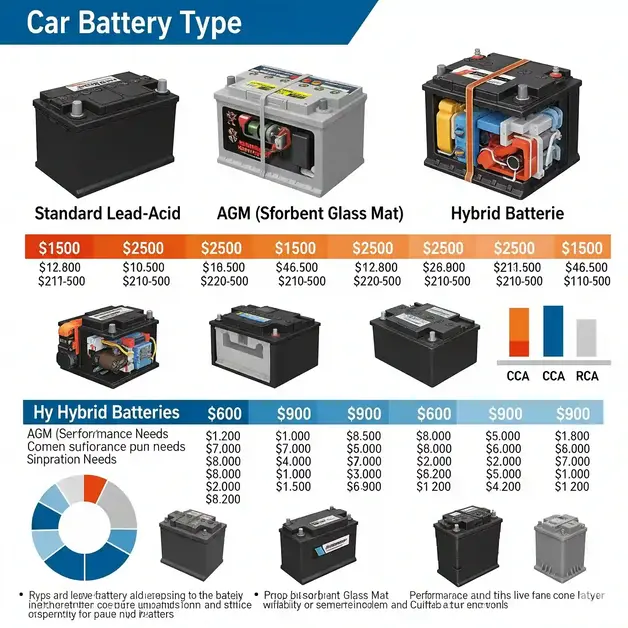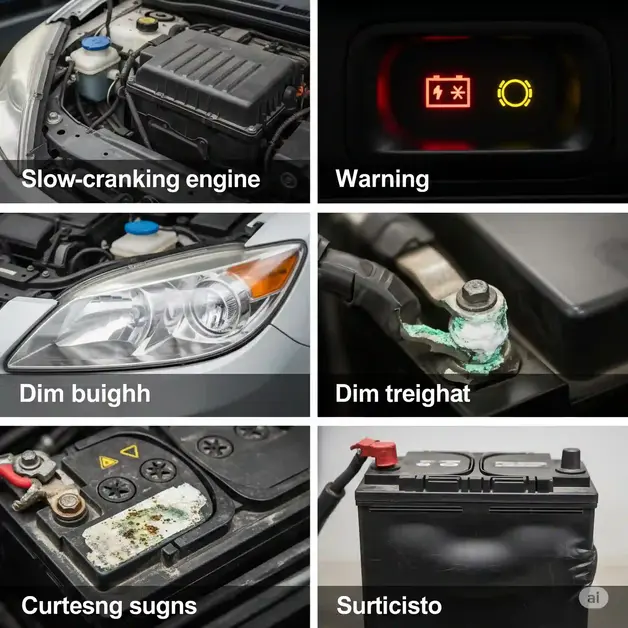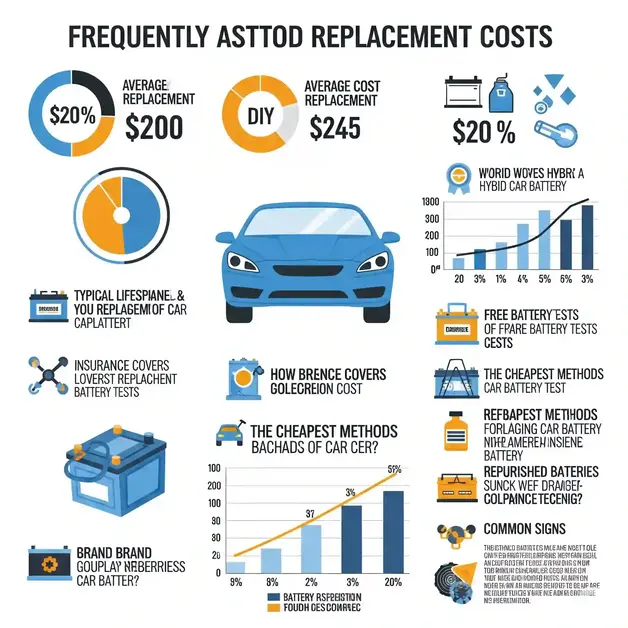It was a Monday morning. I had my coffee, grabbed my keys, and got in the car—ready to start the day. But when I turned the key, nothing happened. My battery was dead. That’s when I found out just how tricky car battery replacement cost can be.
Why Knowing Battery Replacement Cost Matters
Most people don’t think about the battery until the car won’t start. But knowing the battery replacement cost for your car ahead of time can save you stress—and money. I’ve been through it myself, helped friends too, and found that things like weather, driving habits, and even hybrid systems can change the price a lot.
In this guide, I’ll share what I paid, what affects the cost, and how to save—whether you’re buying a new battery for a car or looking into the cost of replacing a battery in a hybrid car. Let’s make sure you’re ready when your battery gives out—no surprises, no stress.
My Real-Life Car Battery Replacement Experience
The morning it happened still annoys me a little—because I should have seen it coming. My car had been dragging when I started it for weeks. You know that slow, sluggish crank that makes you hold your breath? Yeah, that. But I kept pushing it off. Life was busy. I figured it would hang in there a little longer.
Short answer: My car battery failed after warning signs I ignored—and it cost me time, money, and stress.
It was a Monday, of course. I had a full workday ahead, plus errands. I jumped in the car, turned the key… and clicked. Nothing. Not even the usual whining sound. Just silence. I tried again—nothing. That’s when it hit me: the battery was completely dead.
I checked under the hood like I knew what I was doing. (Spoiler: I didn’t.) Terminals looked fine. Lights were totally out. It was dead-dead. I didn’t even have jumper cables with me. So I called a friend who luckily lived nearby, and he gave me a jump just long enough to drive straight to the shop.
Short answer: When your battery dies, it often leaves you with zero warning—and no choice but to get it replaced fast.
I ended up at a local garage I trusted. They tested the battery and confirmed it was toast—voltage way too low. They quoted me around $180 total, including labor. Here’s what I paid:
- Battery (Group 35 AGM): $140
- Installation & test: $25
- Old battery disposal fee: $5
Total: $170
Looking back, that wasn’t bad. But I later found the exact same battery online for $115—with free install at an auto parts store. So yeah, I could’ve saved if I wasn’t in panic mode.
Short answer: I paid $170, but I could’ve saved $50+ by shopping around or using a parts store install deal.
The real lesson? Be proactive. I could’ve avoided the whole mess if I’d tested the battery when the slow cranking started. A simple check would’ve told me it was on its last legs. It’s like waiting for a light bulb to blow before buying a new one—you’re just asking for the worst timing possible.
Now, I test my battery every few months—especially before winter or long trips. And I always keep jumper cables in the trunk. Once you’ve been stranded once, you don’t forget.
Short answer: After this experience, I always test my battery early and keep jumper cables on hand—because one failure was enough.
If your car feels off or the battery’s 3+ years old, don’t wait. Trust that gut feeling. I ignored mine, and it cost me a morning and extra cash I didn’t need to spend. Lesson learned the hard way—so you don’t have to.
Average Car Battery Replacement Cost in the U.S.
So, how much does a car battery replacement cost?
In most U.S. cities, the average cost is between $75 and $200 for a regular car. If you drive a hybrid or an EV, it can be much higher—sometimes into the thousands.
I learned this when I helped a friend replace his hybrid battery. (More on that later.) For gas-powered cars like mine, it’s usually a much easier bill to swallow. Still, the final price depends on your car, battery type, and where you go.
Short answer: Most drivers spend about $150 total for a car battery, including install.
Here’s a quick breakdown of battery prices:
|
Battery Type |
Battery Only |
Installed Cost |
|
Standard Lead-Acid |
$70 – $120 | $100 – $160 |
|
AGM (Absorbent Glass Mat) |
$120 – $200 |
$150 – $250+ |
| Hybrid Battery (NiMH/Li-ion) | $1,500 – $6,000+ |
$2,500 – $20,000 |
Crazy, right? A hybrid battery can cost more than a whole used car. Don’t worry though—we’ll dig into hybrid prices in a later section.
Short answer: Hybrid and EV batteries are expensive. Standard car batteries are much more affordable.
Now here’s something a lot of people miss: where you buy and replace your battery matters.
If you buy from places like AutoZone or Advance Auto, they’ll often install it for free. But at a dealership? You’ll likely pay more—sometimes just for labor. And some shops charge a core fee (usually $15–$25). You get that back when you return your old battery.
Thinking about ordering online? Be careful. The prices may look great, but they often don’t include install or old battery recycling. Unless you’re confident doing it yourself, the savings might vanish fast once you pay a shop.
Short answer: Buy from a store that offers free install. That saves money and time.
Bottom line: replacing a regular car battery doesn’t have to be a big deal. But if you wait until it’s dead, it becomes one fast. A little prep now can save you money, stress, and time later.
Next up, let’s talk about what makes one battery more expensive than another—and how to choose the right one.
What Affects The Battery Replacement Cost?
You might think all car batteries are the same—but nope. Just like phones, shoes, or even coffee, some cost more for good reason. Others? You’re just paying for the brand or convenience. I’ve learned (sometimes the hard way) that a few key things really drive up—or down—the cost of replacing a battery.
Short answer: The cost of a new battery depends on the type, size, car model, warranty, and where you get it installed.
1. Battery Type (Lead-Acid, AGM, or Gel)
Most standard cars use lead-acid batteries. They’re cheap, easy to find, and get the job done. AGM (Absorbent Glass Mat) batteries, on the other hand, are tougher, leak-proof, and often used in newer cars or those with stop-start tech. Gel batteries? Rare, but they show up in high-end or specialty vehicles.
AGMs usually cost more—sometimes twice as much—but they also tend to last longer and handle extreme temps better.
Short answer: Lead-acid batteries are cheapest; AGM batteries cost more but offer better performance and durability.
2. Battery Size and Cold Cranking Amps (CCA)
Ever seen a battery chart with numbers like “Group 35” or “CCA 650”? That’s not just jargon—it matters. Bigger engines need more power to start, especially in the cold. That’s where Cold Cranking Amps (CCA) come in. The higher the number, the better it starts in freezing temps.
Larger batteries and higher CCA ratings cost more. For example, my small sedan needed a Group 35 battery with around 640 CCA. But a friend’s SUV? Group 49, over 800 CCA—and about $50 more.
Short answer: Bigger batteries with higher cold-cranking power cost more—especially for trucks, SUVs, or cold climates.
3. Vehicle Type (SUV, Hybrid, Luxury)
The type of car you drive changes everything. A compact car can get away with a basic lead-acid battery. A luxury sedan or a hybrid? Not so much. Hybrids use high-voltage battery packs, and some luxury cars use dual-battery systems.
I helped a friend replace a Mercedes battery once—and it wasn’t just expensive, it was weird. Hidden in the trunk, special vents, the whole deal. It cost nearly $300 after install.
Short answer: The more advanced or luxurious the car, the more complex and expensive the battery setup.
4. Warranty Length and Brand
Some batteries come with just a 1-year warranty. Others offer 3 to 5 years. You’ll usually pay more for the longer warranty—but it can be worth it. I always ask, “What’s the warranty?” before I buy. A $30 cheaper battery isn’t a deal if it dies in 18 months and isn’t covered.
Also, brand names like Interstate, Optima, or Die Hard often cost more than store brands—but sometimes they last longer and have better support.
Short answer: Longer warranties and trusted brands cost more upfront but can save money in the long run.
5. Installation Fees (Dealership vs. Auto Shop vs. DIY)
This is the sneaky one. The battery might only cost $100—but a dealership may charge $50+ just to install it. Meanwhile, local auto shops or parts stores like AutoZone often do it for free if you buy the battery from them.
I once made the mistake of buying a battery online, then had to pay a shop to install it anyway. Lesson learned.
Short answer: Where you get your battery installed affects the total cost—a dealership is usually the priciest option.
If there’s one thing I’ve picked up through all this, it’s that the “battery price” you see online isn’t the whole story. From the type of battery to where and how it’s installed, the real cost depends on a mix of details you don’t want to ignore.
Now that you know what affects the price, let’s look at hybrid battery replacements—which are a whole different ball game.
Cost of Replacing a Battery in a Hybrid Car
Here’s the honest truth: if you own a hybrid, replacing the battery is a whole different beast. It’s not like swapping a regular 12-volt battery at AutoZone. It’s bigger, more expensive, and—yep—more stressful if you’re not ready for it.
Short answer: Hybrid battery replacement usually costs between $2,500 and $8,000, but some can go as high as $20,000, depending on the model and battery type.
Why Hybrid Batteries Cost So Much More
The price hike isn’t just because of the word “hybrid” on the badge. Hybrid vehicles use high-voltage battery packs—often made of nickel-metal hydride (NiMH) or lithium-ion (Li-ion). These power the electric motor and store way more energy than a normal car battery. They’re complex, heavy, and harder to replace.
Think of it like comparing a flashlight battery to a power station.
And it’s not just the battery itself. Labor costs are higher too. Some hybrid batteries are buried under seats or deep in the rear of the car. It’s not a 10-minute job with a wrench.
Short answer: Hybrid batteries are large, high-voltage packs that cost more in both parts and labor due to their size and complexity.
Real-World Examples (Based on My Research)
Here’s a look at what it really costs for a few popular hybrid models:
| Hybrid Model | Battery Type |
Replacement Cost (Parts + Labor) |
|
Toyota Prius (Gen 3) |
NiMH | $2,000–$3,000 |
| Honda Accord Hybrid | Li-ion |
$3,000–$6,000 |
|
Ford Fusion Hybrid |
Li-ion | $5,000–$8,000 |
| Chevy Volt (Plug-in EV) | Li-ion |
$6,000–$12,000+ |
When I helped a friend replace the battery on his Prius, we called around and found prices all over the place—from $1,900 for a refurbished unit to $3,500 for a brand-new OEM one at the dealer. In the end, we went with a refurbished pack from a local hybrid specialist for $2,200 with a 3-year warranty—and it’s been running great since.
Short answer: Costs vary by brand and battery type—expect to pay more for newer, larger Li-ion packs.
Refurbished vs. New Hybrid Batteries
Here’s where it gets interesting—and where you might save some serious cash.
Refurbished batteries are usually old packs that have had their bad cells replaced. They’re not brand-new, but they often come with a 1–3 year warranty. If you’re planning to keep the car just a few more years, it might be the perfect middle ground.
New OEM (original equipment manufacturer) batteries offer peace of mind, but you’ll pay a premium. And if you’re buying from a dealership, expect the highest quote on the board.
Short answer: Refurbished batteries are cheaper and may be a smart choice if you’re not keeping the car long-term.
If you drive a hybrid, knowing these numbers ahead of time can save you a world of stress. It’s one of those things you hope not to deal with—but when it happens, it’s better to be ready. That’s exactly why I researched it in the first place—not just for me, but for a friend who was caught off guard.
And now that you know what hybrid battery replacement really costs, let’s take a look at how to spot the signs that your car battery—regular or hybrid—is starting to fail.
Signs You Might Need a New Car Battery
Sometimes your car tells you it’s not feeling well—you just have to know how to listen. A weak or dying battery is one of those issues that sneaks up on you. One morning, you’re headed to work. The next? Silence when you turn the key. Let’s make sure that doesn’t happen.
Short answer: Slow starts, dim lights, and dashboard warnings are early signs your battery might be failing.
1. Your Engine Cranks Slowly
This was my first red flag. I turned the key and instead of that quick vroom, I got a slow, lazy rrrrrrr-click. It started—but barely. If your engine cranks slower than usual, that’s your battery waving a white flag.
Short answer: A slow engine crank usually means your battery doesn’t have enough power to start the car properly.
2. Your Battery Warning Light Is On
That little battery-shaped icon on your dashboard? Don’t ignore it. It doesn’t just mean your battery is dying—it could also mean a problem with the alternator or charging system. Either way, it’s a heads-up that your car’s electrical system needs attention.
Short answer: If the battery light is on, your car may not be charging the battery correctly—get it checked ASAP.
3. Electrical Things Start Acting Weird
If your radio resets, your power windows move slowly, or your headlights dim when you idle—yep, that’s likely a battery issue. Modern cars rely heavily on electronics, and a weak battery can’t keep everything running smoothly.
Short answer: Dim lights and glitchy electronics often mean the battery is too weak to support your car’s systems.
4. You See Corrosion Around the Battery Terminals
Pop the hood and take a look. If there’s crusty white or bluish stuff on the battery terminals, that’s corrosion. It messes with the connection and can keep your car from starting. Cleaning it might help short-term, but long-term buildup usually means it’s time for a new battery.
Short answer: Corrosion blocks the battery’s connection—if it keeps coming back, you may need a replacement.
5. The Battery Case Looks Swollen or Leaking
Extreme heat (or cold) can damage your battery’s case. If it looks bloated or is leaking acid, don’t touch it—just replace it. A swollen case is dangerous and could lead to failure at the worst possible time.
Short answer: A swollen or leaking battery is a clear sign it’s damaged and should be replaced immediately.
6. It’s 3–5 Years Old (or Older)
Batteries aren’t made to last forever. Most will last 3–5 years, depending on the climate, driving habits, and how often your car sits unused. If your battery’s past its birthday, it’s smart to get it tested—especially before winter or a long trip.
Short answer: If your battery is more than 3 years old, get it tested even if it’s not showing obvious symptoms yet.
Quick Checklist: Signs You Might Need a New Battery
- Slow engine start
- Battery light on
- Dim lights or weak power windows
- Clicking sound when starting
- Corroded terminals
- Swollen or leaking case
- Battery age: 3+ years
If you notice even one or two of these signs, it’s worth heading to your local auto parts store or mechanic for a free battery test. Catching it early can save you from getting stranded—and from overpaying in a panic later.
Up next, let’s look at where to actually buy a battery and who will install it without charging you a fortune.
Where to Buy and Replace Your Battery
When my battery died, I had two choices: call a tow truck or figure things out fast. If you’re in that situation (or planning ahead, which is way smarter), here’s what I learned from trying almost every option out there. Some are quick and cheap. Others are convenient but pricey. Knowing where to buy and install your battery can save you real money.
Short answer: The best places to buy and replace a battery are auto parts stores like AutoZone or O’Reilly—they often include free installation.
1. Dealership – Reliable but Expensive
If your car is still under warranty or you drive a luxury brand, you might be tempted to go to the dealership. And sure, it’s safe—they know your car inside and out. But man, you’ll pay for that peace of mind. The same battery that costs $130 at an auto store might cost $200 or more at the dealer, plus $50+ for labor.
Short answer: Dealerships are convenient for brand-specific batteries but usually the most expensive option.
I once checked with a dealership just to compare—and the quote made my jaw drop. Unless your battery is covered under a factory warranty, I’d skip it unless you have no other choice.
2. Auto Parts Stores – Best Bang for Your Buck
This is where I usually go now. Stores like AutoZone, O’Reilly, Advance Auto, and even NAPA will not only sell you a battery—they’ll install it for free in most cases. Seriously. They even take the old one for recycling, so you don’t have to deal with disposal.
Short answer: Auto parts stores usually offer free installation and competitive prices, making them a great all-around option.
Last time I replaced mine, I got a Duralast Gold at AutoZone. Cost me $160, installed in the parking lot in under 15 minutes. No extra fees. Done and dusted.
3. Local Mechanics or Mobile Installers
Sometimes it’s worth paying a little more for a local mechanic you trust. Especially if your battery’s location is a pain (hello, hidden under the back seat). A mechanic might charge $20–$50 for labor, but they’ll also make sure your alternator and connections are solid—which auto parts stores usually don’t.
Short answer: Mechanics offer professional installation and diagnostics, but expect a labor fee.
There are also mobile services like YourMechanic or Wrench that come to your house. I tried one once when I couldn’t get a jump—and while it cost a bit more, it saved me from towing.
4. DIY – When It’s Worth Doing Yourself
If you’re handy and have a socket wrench, swapping a battery isn’t rocket science. I’ve done it in my driveway a couple of times. The catch? You need to make sure you disconnect things properly, avoid shorting any electronics, and dispose of the old battery safely.
Short answer: DIY saves you the labor cost, but only attempt it if you’re comfortable under the hood.
For DIY installs, Amazon has a wide selection of affordable car batteries you can have delivered right to your door. And if something goes wrong? You’re on your own.
Final Thoughts on Where to Buy & Replace
If you’re asking me where to go? Auto parts stores win for most people. They offer solid batteries, quick installs, and no surprise fees. Dealerships and mobile services have their place—but only if you’re after convenience or need a brand-specific solution.
Knowing your options now means you’re not Googling “car won’t start” in a gas station parking lot. Trust me—I’ve been there. Let’s keep moving and talk about how you can actually save money when it’s time to swap your battery.
Tips to Save on Car Battery Replacement
Nobody wants to spend more than they have to—especially on a car battery. I’ve learned a few tricks (some the hard way) that can help you keep costs down without cutting corners. Whether your battery just died or you’re planning ahead, these simple tips can save you cash and stress.
Short answer: You can save money on a car battery by comparing prices, looking for free installation, using memberships, and avoiding unnecessary replacements.
Compare Prices Before You Go
The price for the same battery can vary a lot depending on where you shop. I once called three different stores, and one quoted me $50 more than the others—for the exact same brand and model. A quick online check before you head out can shave off a good chunk of change.
Short answer: Always check prices online and between stores before buying—it can save you $30 or more.
You can also check Amazon’s car battery listings by typing in your car model. Just make sure it matches your battery group size. If a local store has a better deal, ask the others to match it. Many do.
Ask About Free Installation
Some stores offer free installation when you buy the battery from them. Others don’t—but they won’t tell you unless you ask. I found this out at Advance Auto when the employee casually said, “We can install it for you right now.” No charge. That saved me at least $25 in labor.
Short answer: Many auto parts stores install your battery for free—just ask before you buy.
This is especially helpful if you’re not comfortable doing it yourself. It’s quick, clean, and often done while you wait in the parking lot.
Use Membership Perks (AAA, Costco, etc.)
If you’re a member of AAA, Costco, or Sam’s Club, check your benefits. AAA will often come to your house, test your battery, and replace it on the spot—with the battery included. Costco batteries are priced well, too, though you’ll need to install it yourself or take it to a shop.
Short answer: Membership programs like AAA and Costco can get you cheaper batteries or mobile installation services.
When I helped a friend with their battery, AAA showed up within 30 minutes and handled the whole swap. They even gave him a $22 discount for being a Plus member.
Consider Refurbished Batteries (If You’re On a Budget)
If money’s tight and you’re not planning to keep the car forever, a refurbished or reconditioned battery might be worth a look. You’ll find these at local battery shops or recyclers. They usually cost 30–50% less than new ones and still come with a short warranty.
Short answer: Rebuilt or refurbished batteries are cheaper and can work well for older vehicles or short-term use.
That said, I only recommend this if your car isn’t picky and you’re OK with a shorter battery lifespan. Some sellers on Amazon also offer refurbished or certified used batteries—just read the reviews first.
check the return policy. Test It First—It Might Just Need a Charge
One time, I thought my battery was toast. The engine barely turns over, and the lights were dim. Turns out, I’d left the dome light on overnight. A simple jump-start and charge brought it back to life. That saved me from buying a brand-new battery I didn’t need.
Short answer: Before replacing your battery, test or charge it—it could save you from buying one unnecessarily.
Most parts stores (AutoZone, Advance, O’Reilly) will test your battery for free. If it’s just low on juice, a trickle charger might be all you need.
Wrap-Up: Small Moves = Big Savings
Car battery replacements aren’t cheap, but you’ve got more control than you think. With a little research and the right timing, you can avoid surprise fees and stretch your dollar further. The key is not to panic when your battery starts acting up—just slow down, compare options, and don’t be afraid to ask for a better deal.
Knowing these tricks has saved me time, money, and a few headaches. And trust me, when your car starts without hesitation in the middle of winter—you’ll be glad you planned ahead.
FAQs About Car Battery Replacement Cost
How much does it cost to replace a car battery?
Car battery replacement cost ranges from $75 to $200 for regular cars. Hybrids can cost $2,500 to $8,000 or more depending on battery type and model.
Is it cheaper to replace a battery yourself?
Yes. Replacing a car battery yourself can save $20 to $50 in labor fees. But only do it if you’re comfortable working under the hood.
How long do car batteries last?
Most car batteries last 3 to 5 years. Driving habits, climate, and battery type affect the lifespan. Always test before long trips or winter.
Are hybrid car batteries always more expensive?
Yes. Hybrid battery replacement costs are higher due to complex parts. Prices range from $2,000 to over $10,000, depending on the car and battery.
Will insurance cover a dead car battery?
Car insurance doesn’t cover normal battery wear. Some roadside plans like AAA may help with battery jumps or mobile replacement service.
Can I get a free battery test before replacing it?
Yes. Most auto parts stores like AutoZone and Advance Auto offer free battery testing. This can help avoid buying a new one if it’s still good.
Does the battery brand affect the replacement cost?
Yes. Premium brands like Optima or DieHard cost more but often last longer. Budget brands are cheaper but may offer shorter warranties.
What’s the cheapest way to replace a car battery?
Buy from a store that offers free installation, compare prices online, and ask for discounts. Membership perks from AAA or Costco can also help.
Are refurbished car batteries worth it?
They can be. Refurbished batteries cost less—usually 30–50% off. They’re best for older cars or if you’re not keeping the vehicle long-term.
How do I know when my battery needs to be replaced?
Look for slow starts, dim lights, dashboard warnings, or corrosion. If the battery is over 3 years old, get it tested—even if it seems fine.
Final Thoughts – Plan Ahead, Save More
If you like to stay ahead of car troubles and hate last-minute stress, learning about car battery replacement cost now will save you later. But if you’re someone who waits until the car won’t start, just know—it’ll likely cost more and ruin your morning. I’ve been there, and I don’t recommend it.
The truth is, a battery isn’t just another part—it’s your car’s heartbeat. Take care of it, test it often, and keep jumper cables in the trunk. Trust me, in the future you will thank you.

